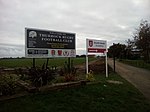Orsett Rural District
Orsett Rural District was the local government district centred on Orsett in south Essex, England from 1894 to 1936; a little of its far west is in modern Greater London. Likewise in modern terms the area is mostly east of the M25 motorway and north of the Thames Estuary. It was formed in 1894. Housing quite a few residents, it gradually fell from 62.4 to 49.6 square miles. Its notable omission was Grays or Great Thurrock; Thurrock was the main successor district. From 1835 until 1894, its parishes fell in the Orsett Poor Law Union (see the Poor Law Amendment Act 1834). For sewerage purposes from 1875 (with Grays Thurrock until 1886) they formed the Orsett Rural Sanitary District, and during the latter's currency the divorce of Civil parishes in England from ecclesiastical parishes finalised nationally.
Excerpt from the Wikipedia article Orsett Rural District (License: CC BY-SA 3.0, Authors).Orsett Rural District
Long Lane, Thurrock
Geographical coordinates (GPS) Address Nearby Places Show on map
Geographical coordinates (GPS)
| Latitude | Longitude |
|---|---|
| N 51.5 ° | E 0.35 ° |
Address
Long Lane
Long Lane
RM16 2QP Thurrock
England, United Kingdom
Open on Google Maps








